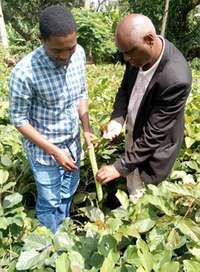Most farmers know very well that in a forest many plants grow all the time, but the soil never wears out. The soil in a forest also never gets so hard that someone has to plow it. Even more amazing, the plants in a forest do not suffer from droughts. In other words, forest soils stay productive, soft and moist for thousands of years all by themselves. Green manure/cover crops, like jack beans, are some of the plants from the forest that have done the best job of keeping the forest soils healthy for thousands of years. Mankind have selected these plants as green manure/cover crops because they keep the soil healthy, but they also allow us to grow our maize and other food crops along with them on the same land and at the same time.
Once we learn how to grow green manure/cover crops in our fields, we can grow food and at the same time, make our soils more fertile, softer, and more moist. Therefore, after a few years, our soils will stay fertile and soft just as the soils in the forest, but we will still be able to grow our crops. Basically, it will be like fallowing the land, just as our grandfathers did, but in a way that allows us to continue to grow food in the same fields at the same time.
Jack beans (Canavalia ensiformis)

Figure 3. Charles Bonaventure inspects a Jack bean plot.
Jack beans are the most drought-resistant of all the bushy-type green manure/cover crops. They grow very well in the poorest of soils—even where maize will no longer grow. They also fix a huge amount of nitrogen (up to 240 kg per hectare—more than anyone would ever apply as fertilizer), which means that they improve the fertility of the soil more than any other plant known in Africa. Furthermore, neither cattle nor locusts will eat jack bean plants. Jack beans are the best plants of all the green manure/cover crops for improving soils/land that have lost their productivity. They can even improve the fertility of highly damaged land that no longer produces anything. Bushy-type jack beans can be intercropped very well with maize, sorghum, millet, or cassava to start restoring the soil without losing any of the production of our normal crops. Sometimes, if we intercrop jack beans with other crops, our crops will suffer up to a 15% decrease in yields for the first year (or 25% if there is bad drought), but our crops will enjoy at least 50% increase in yield by the second year. This is a good reason for always trying out a new technology on a small scale the first year. That way, the second year, the increase in yields of that plot will make up for the 25% decrease on a larger piece of land. Therefore, we never have to suffer a 25% decrease in yield on all of our land in any one year.
How to plant jack bean
Jack beans should be planted at a rate of 3 to 4 seeds per square meter, right in our maize fields, and at the same time as we plant the maize. Then they should be left to grow through the dry season, because the leaves fertilize the soil much better if they are green when they are applied to the soil. Dead, dry leaves have lost most of their fertilizer. Then, just before the rains come, the jack bean plants are cut down and their leaves left on top of the soil. At that time or before, new jack bean seeds are harvested, then planted again along with the maize.
Jack bean pods and seeds
The thin, immature pods of the jack bean plant are edible. However, we recommend eating them only in small quantities and as a famine food—when people have nothing else to eat. The rest of the jack bean plant cannot be eaten without a lot of extra preparation, Therefore, within one, two, or three years, when the land has become more productive, we usually quit using jack bean on that land, and instead use some other green manure/cover crop that is edible, such as lablab beans or pigeon peas. We may prefer not to use these plants the first two or three years, because they may not grow well in worn-out soils—they do much better in soils that have already been improved by the jack beans. In areas where firewood is extremely scarce, the large jack bean pods can also be used as firewood.
You may learn more about Jack bean and other green manures/cover crops to fertilize the soil and overcome droughts from the book “Restoring the Soil” Second Edition [http://edn.link/edrmne] by Roland Bunch. For more information, please reach out to Sophia Kasubi through email: skasubi@echocommunity.org